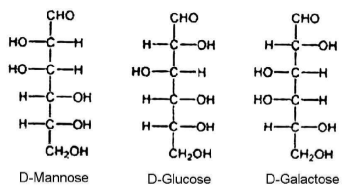 Multiple Choice Questions
Multiple Choice QuestionsAbility of a membrane protein to span the lipid bilayer strictly depends on the presence of
Zinc finger domain
α-helices
parallel beta sheet
antiparallel beta sheet
Following are structures or stereoisomers of aldohexoses which deffer in the stereochemistry:

Based on the above structure following information was given below:
(a) D- glucose and D-mannose are epimers because they differ in the stereochemistry at C-2 position.
(b) D-glucose and D-galactose are epimers because they differ in the stereochemistry at C-4 position.
(c) D-mannose and D-glucose are epimers because they differ in the stereochemistry at C-3 position.
(d) D-galactose and D-glucose are epimers because they differ in the stereochemistry at C-5 position.
Choose one of the correct combinations of above statements:
(a) and (b)
(c) and (d)
(b), (c) and (d)
(a) and (d)
Following statements are made related to protein structure
(a) The hydrogen bonding patterns between the CO and NH groups are: n → n + 3 in α-helix; n → n + 4 in 310 helix and n → n + 5 in π helix.
(b) In a b turn, there are 10 atoms between the hydrogen bond donor and acceptor.
(c) In a g turn, there are 6 atoms between the hydrogen bond donor and acceptor.
(d) Parallel sheets have evenly spaced hydrogen bonds, which bridge the strands at an angle.
Which one of the following combinations of above statements is correct?
(a0 and (c)
(a) and (b)
(c) and (d)
(d) and (b)
The following statements are made on nucleic acid structure:
(a) In the B-form of DNA, the sugar pucker is C2' endo.
(b) In RNA, the sugar pucker is C3' exo.
(c) The wobble base pair is formed between G and A in RNA.
(d) A change in the sugar pucker from C2' endo in the B form of DNA to C3' endo alters the width and depth of the major groove.
Which one of the following combinations of above statements is correct?
(a) and (c)
(b) and (d)
(a) and (d)
(b) and (c)
The Vmax and Km from a Lineweaver- Burk plot of an enzyme reaction where 1/V = 40 µM-1 min at 1/[S] = 0 and 1/[S] = -1.5 × 102 mM-1 at 1/V = 0 are
0.025µM min-1 and 0.67 × 10-2mM
0.025µM min-1 and 0.67 × 10-2mM-1
0.025µM min-1 and 1.5 × 10-2mM-1
0.038µM min-1 and 0.67 × 10-2mM
From the following statements:
(a) Biosynthesis of proteins and nucleic acids from precursors results in production of chemical energy in the form of ATP, NADH, NADPH and FADH2.
(b) The spontaneity of a reaction in cells does not depend whether ΔG0 for the reaction is positive or negative.
(c) Both oxidative phosphorylation and photophosphorylation involve oxidation of H2O to O2.
(d) Only chemical potential energy contributes to proton motive force in mitochondria.
Which one of the following combinations represents all INCORRECT statements?
(a), (b), (c)
(b), (c), (d)
(b), (c), (d)
Two liposome preparations (“X” and “Y”) are made using basic lipid composition as phosphatidylcholine (PC) and cholesterol (Chol). In “Y” a ganglioside (asialo-GM1) is incorporated during the preparation besides PC and Chol. In an attempt to find out the localization of asialo-GM1 in the membrane bilayer of “Y” (taking “X” as a negative control) and considering liposome as a true depiction of lipid bilayer structure of cellular membrane, following reagents are provided as probes:
(a) Phospholipase A
(b) Galactose binding lectin
(c) Exoglycosidase
(d) Cyclodextrin
Choose the most appropriate reagent(s) from the above list to ascertain the localization of asialo-GM1.
Only (a)
Both (c) and (d)
Both (b) and (c)
Both (a) and (d)
Areas of the three rectangles inside the full rectangle are given in the diagram.

What is the area of the full rectangle?
36
48
72
96
